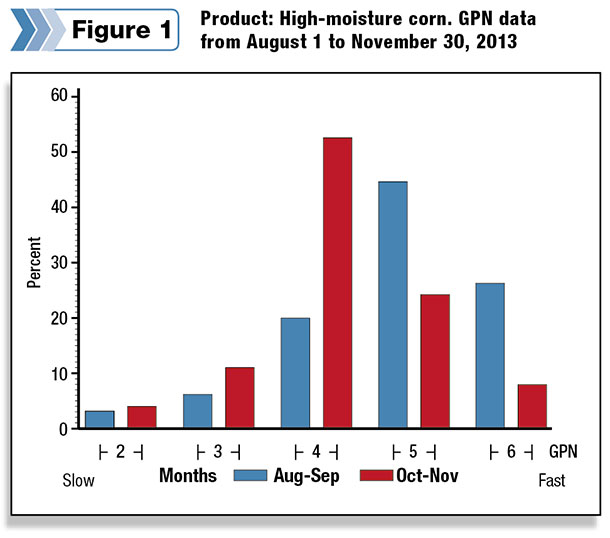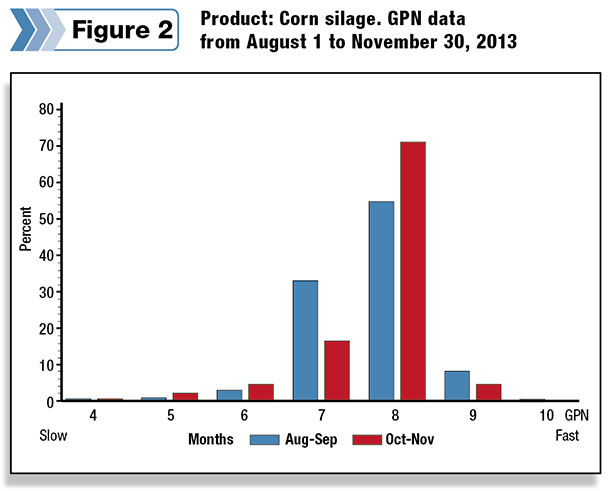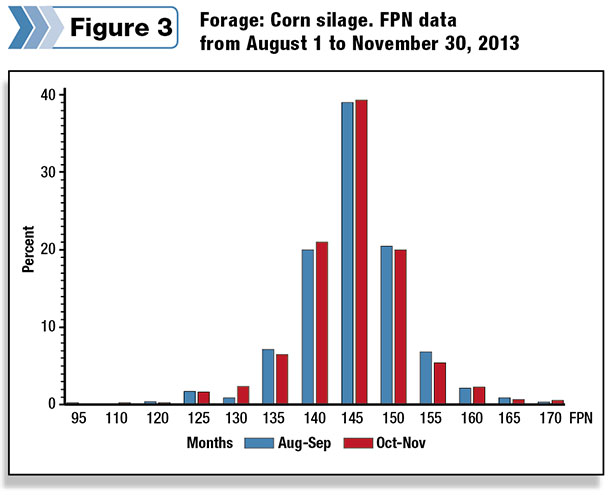Making the switch from old-crop corn silage to new-crop corn silage each year can oftentimes challenge milk production, particularly if the new-crop corn silage hasn’t had enough time to ferment. Depending upon location, some dairy producers may already be faced with feeding the recently harvested 2013 corn crop.
The less time a corn crop has had to ferment, typically the less ruminally available the starch in the corn silage will be. We have been studying starch and fiber digestibility for 10 years now.
Utilizing proprietary measurements, GPN and FPN, we evaluate ruminal starch digestibility and neutral-detergent fiber digestibility (NDFd). GPN measures how digestible and available starch will be to the rumen microbes. FPN measures how digestible the fiber will be and as a result how much rumen fill there will be.
Rumen fill has a direct impact on dry matter intake (DMI), diet digestibility and feed efficiency. In fact, research shows that a one-unit increase in in vitro digestibility of neutral-detergent fiber (NDF) was associated with a 0.37-pound per day increase in DMI and a 0.55-pound per day increase in 4 percent fat-corrected milk yield per cow.
As a frame of reference for ruminal starch digestion, a GPN score of 1 equals slow-digesting (less available to rumen microbes) and a GPN score of 11 indicates a fast-digesting starch (more available to rumen microbes). For fiber, the FPN scale is an index of ruminal fiber digestibility ranging from 60 (slow or low-ruminal NDF digestion) to 180 (fast or high-ruminal NDF digestion).
As dairy producers make the switch from the 2012 old corn crop to the 2013 new corn crop, a change in availability and digestibility of starch and fiber is to be expected. If monitored and adjusted for, big swings in milk production can be potentially avoided when switching crops.
Laboratory tests have allowed us to capture the changes in starch and fiber digestibility in real-time as dairy producers make the switch in crops. As can be seen in Figure 1 and Figure 2 , on average the drop in the GPN score from the end of the 2012 crop (August to September) to the start of the 2013 crop (October to November) is higher for high-moisture corn (172 samples) than for corn silage (1,317 samples).


During the same timeframe, FPN scores (ruminal NDF digestibility) have remained relatively unchanged ( Figure 3 ).

Even in the absence of an overall decrease in the ruminal starch digestibility, new-crop corn silage can present additional challenges outside of how available the starch will be and digestible the fiber will be. If the corn kernels in the corn silage have not been adequately processed due to excessive hardness, the cows will have challenges ruminating them, which can reduce access to microbial digestion.
Corn kernel processing, due to particularly hard corn kernels, proved to be an issue in 2012 and early reports suggest this will continue to be an issue as the 2013 crop is fed. To combat this issue, corn silage should be left to ferment longer, if possible.
In dealing with the 2013 corn crop, nutritionists may need to raise the total rumen-degradable starch (RDS) score or amount in the ration higher than they had at the end of the 2012 crop to compensate for lower microbial access. Therefore, to overcome the loss or depression in starch digestibility in the new corn crop, more starch is needed in the ration to compensate for the change.
Consider raising the RDS amount in the ration by 5 to 10 percent and then lower it as the corn silage has had a chance to ferment in the storage structure. Look at bringing in more degradable starch with ingredients other than corn silage.
By maintaining a higher RDS level, you can account for the drop in GPN score that can occur as you switch from old-crop corn silage to new-crop corn silage, as well as any challenges presented by poorly processed corn kernels.
Additional starch may also be needed to compensate for the situation where corn silage wasn’t well-processed, or high-moisture corn wasn’t well-ground, because animals won’t ruminate those hard particles well.
But keep in mind if this corn endosperm protein matrix dissolves at a faster rate than normal during fermented storage, then all of that extra RDS is going to negatively affect milk fat, probably sometime in the spring, and rations will need to be readjusted downward in RDS.
Looking at the numbers from the 2013 crop we’ve received to date, it is safe to say that most nutritionists may have to run higher RDS levels in early winter because some starch-containing ingredients don’t appear to have been processed as well.
Responses in milk volume to increased RDS will dictate how much higher. In three to six months, this should be less of a problem. Starch degradability should go up, and large particle size won’t be as problematic. At that time, nutritionists will likely need to reduce starch out of the ration, accounting for the increased availability. PD
David Weakley has a Ph.D. in animal nutrition from Oklahoma State University and an MS in dairy science from the University of Wisconsin – Madison. He is employed by Forage Genetics International and has more than 30 years of experience in ruminant nutrition.
References omitted due to space but are available upon request. Click here to email an editor.

-
David Weakley
- Director- Dary Forage Research
- Calibrate Technologies
- Email David Weakley






